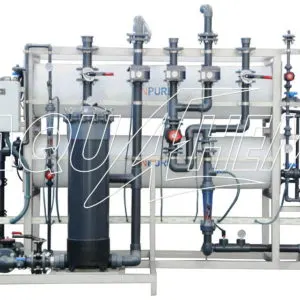Electro Deionization Systems (EDI)
The modern form of deionization process is electrodeionization system (EDI) and is based on the principle of reverse osmosis and purification of electrolytic water with a conductivity of less than 50 microsiemens/cm.
Electrodeionization is a water treatment technology that utilizes an electricity, ion exchange membranes and resin to deionize water and separate dissolved ions (impurities) from water. It differs from other water purification technologies in that it is done without the use of chemical treatments and is usually a polishing treatment to reverse osmosis (RO). There are also EDI units that are often referred to as continuous electrodeionization (CEDI) since the electric current regenerates the resin mass continuously.
The EDI process produces industrial process water of very high purity, using less than 95% of the chemical products used in the conventional ion exchange processes. With EDI system membranes and electricity replace the million gallons of acid and caustic chemicals that the old processes required daily.
Some of the advantages of the EDI as opposed to the conventional systems of ionic interchange are:
– Simple and continuous operation
– Chemicals for regeneration completely eliminated
– Cost effective operation and maintenance
– Low power consumption
– Non pollution, safety and reliability
– It requires very few automatic valves or complex control sequences that need supervision by an operator
– It requires little space
– It produces high pure water in a constant flow
– It provides complete removal of dissolved inorganic particles
– In combination with reverse osmosis pre-treatment, it removes more than 99.9% of ions from the water





